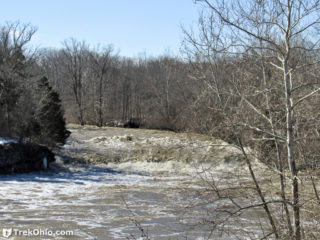 In February 2014 we visited Greenville Falls State Scenic River Area, north of Dayton. It is a 92-acre park, owned by the Ohio Department of Natural Resources but managed by the Miami County Part District. The falls consist of a scenic, 20-foot cascade in Greenville Creek. The park also features ruins of historical interest, nearly a mile of trail, access to fishing spots, a limestone natural arch, picnic areas, kiosks, interpretive signs, and a port-a-potty.
Richard M. Albery, Sr. Read more ➜
In February 2014 we visited Greenville Falls State Scenic River Area, north of Dayton. It is a 92-acre park, owned by the Ohio Department of Natural Resources but managed by the Miami County Part District. The falls consist of a scenic, 20-foot cascade in Greenville Creek. The park also features ruins of historical interest, nearly a mile of trail, access to fishing spots, a limestone natural arch, picnic areas, kiosks, interpretive signs, and a port-a-potty.
Richard M. Albery, Sr. Read more ➜ Greenville Falls State Scenic River Area
 In February 2014 we visited Greenville Falls State Scenic River Area, north of Dayton. It is a 92-acre park, owned by the Ohio Department of Natural Resources but managed by the Miami County Part District. The falls consist of a scenic, 20-foot cascade in Greenville Creek. The park also features ruins of historical interest, nearly a mile of trail, access to fishing spots, a limestone natural arch, picnic areas, kiosks, interpretive signs, and a port-a-potty.
Richard M. Albery, Sr. Read more ➜
In February 2014 we visited Greenville Falls State Scenic River Area, north of Dayton. It is a 92-acre park, owned by the Ohio Department of Natural Resources but managed by the Miami County Part District. The falls consist of a scenic, 20-foot cascade in Greenville Creek. The park also features ruins of historical interest, nearly a mile of trail, access to fishing spots, a limestone natural arch, picnic areas, kiosks, interpretive signs, and a port-a-potty.
Richard M. Albery, Sr. Read more ➜ 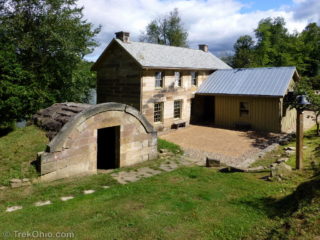 The Stone House Museum is located in Salt Fork State Park in southeastern Ohio. It was built circa 1840 in the Federal style, and it housed three generations of Benjamin Kennedy's family. In 1975 it was listed on the National Register of Historical Places, and in 1999 a charitable organization was launched to raise funds and to oversee the house's restoration. In 2003 the stone house was officially dedicated as a museum.
The Kennedys
With the intention of becoming a sheep farmer,
The Stone House Museum is located in Salt Fork State Park in southeastern Ohio. It was built circa 1840 in the Federal style, and it housed three generations of Benjamin Kennedy's family. In 1975 it was listed on the National Register of Historical Places, and in 1999 a charitable organization was launched to raise funds and to oversee the house's restoration. In 2003 the stone house was officially dedicated as a museum.
The Kennedys
With the intention of becoming a sheep farmer, 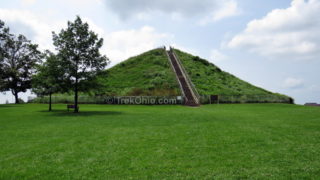 No one knows the their name. They left no written record. Today we call them the Adena Culture and we know they had a thriving civilization in Ohio between 1000 BC and 200 BC. They built hundreds of earthen mounds, probably as part of a funeral ritual. The largest of these mounds is a 65 foot tall mound situated on a hill overlooking the Miami River in Miamisburg, OH.
The mound was partially excavated and a bark covered skeleton was discovered. The Miamisburg mound has never been
No one knows the their name. They left no written record. Today we call them the Adena Culture and we know they had a thriving civilization in Ohio between 1000 BC and 200 BC. They built hundreds of earthen mounds, probably as part of a funeral ritual. The largest of these mounds is a 65 foot tall mound situated on a hill overlooking the Miami River in Miamisburg, OH.
The mound was partially excavated and a bark covered skeleton was discovered. The Miamisburg mound has never been 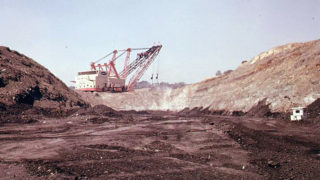 Two months ago we visited the site of a former coal strip-mine in eastern Ohio. The area was the site of a massive surface mine that supplied 110 million tons of coal for electric power generation in the region. Big Muskie — one of the largest earth-moving machines in the world — operated in this area. The bucket of this leviathan was large enough to hold two full size buses.
Mining operations involved removal of all surface vegetation, topsoil, and the earth overlying the coal
Two months ago we visited the site of a former coal strip-mine in eastern Ohio. The area was the site of a massive surface mine that supplied 110 million tons of coal for electric power generation in the region. Big Muskie — one of the largest earth-moving machines in the world — operated in this area. The bucket of this leviathan was large enough to hold two full size buses.
Mining operations involved removal of all surface vegetation, topsoil, and the earth overlying the coal 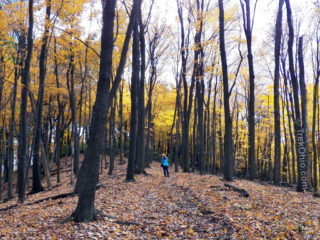 The weekend before last Bob and I paid a visit to Great Seal State Park in Ross County, Ohio. This 1862-acre park features 5 miles of nature trail plus an additional 17 miles of multi-use trails that may be used for hiking, mountain biking and horseback riding. The central feature of the park is a line of hills that are depicted on the Great Seal of Ohio.
The Great Seal Of Ohio
Just like the United States has a great seal (pictured here), all of the individual states have their
The weekend before last Bob and I paid a visit to Great Seal State Park in Ross County, Ohio. This 1862-acre park features 5 miles of nature trail plus an additional 17 miles of multi-use trails that may be used for hiking, mountain biking and horseback riding. The central feature of the park is a line of hills that are depicted on the Great Seal of Ohio.
The Great Seal Of Ohio
Just like the United States has a great seal (pictured here), all of the individual states have their 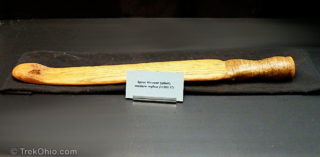 While attending the Ohio Pawpaw Festival in Athens, I got the opportunity to try out an ancient weapon — the atlatl. The atlatl is also known as a spear thrower; although, today the spear is referred to as a dart. Since the dart is fletched with feathers, it looks a like a really long arrow. The atlatl was used by the earliest Paleoindian cultures in Ohio. It continued to be the primary weapon of Native Americans in Ohio until it was displaced by the bow and arrow in the late woodland period.
To
While attending the Ohio Pawpaw Festival in Athens, I got the opportunity to try out an ancient weapon — the atlatl. The atlatl is also known as a spear thrower; although, today the spear is referred to as a dart. Since the dart is fletched with feathers, it looks a like a really long arrow. The atlatl was used by the earliest Paleoindian cultures in Ohio. It continued to be the primary weapon of Native Americans in Ohio until it was displaced by the bow and arrow in the late woodland period.
To 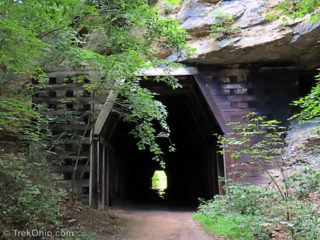 Mineral, Moonville, Hope — all were towns active in Ohio's mining and iron manufacturing industries during the 19th century. They were connected by the Moonville rail line which passed through two long tunnels on the way to the iron furnace at Hope.
The towns are long gone, as is the rail line, but the two tunnels remain and can be found in the Zaleski State Forest. The more famous of the two is the Moonville Tunnel which is the subject of numerous ghostly tales. We visited the Moonville
Mineral, Moonville, Hope — all were towns active in Ohio's mining and iron manufacturing industries during the 19th century. They were connected by the Moonville rail line which passed through two long tunnels on the way to the iron furnace at Hope.
The towns are long gone, as is the rail line, but the two tunnels remain and can be found in the Zaleski State Forest. The more famous of the two is the Moonville Tunnel which is the subject of numerous ghostly tales. We visited the Moonville 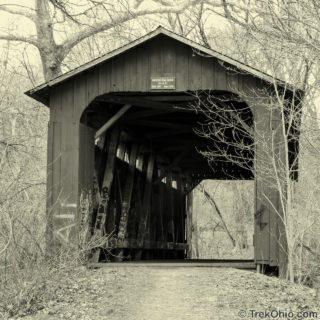 In our visits to Ohio's parks and preserves we've seen many wooden, covered bridges. Since wood was a cheap and plentiful in the 19th century, it was used in the construction of bridges across the many creeks and streams of Ohio. Unfortunately, a wooden bridge exposed to the elements - sun, rain, snow, ice has a a short lifespan - perhaps as short as 10 years. By adding wood siding and a pitched roof, the bridges lifespan can be greatly extended - perhaps as long as 80 or 100 years. This was the
In our visits to Ohio's parks and preserves we've seen many wooden, covered bridges. Since wood was a cheap and plentiful in the 19th century, it was used in the construction of bridges across the many creeks and streams of Ohio. Unfortunately, a wooden bridge exposed to the elements - sun, rain, snow, ice has a a short lifespan - perhaps as short as 10 years. By adding wood siding and a pitched roof, the bridges lifespan can be greatly extended - perhaps as long as 80 or 100 years. This was the 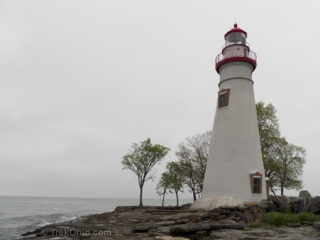 Marblehead Lighthouse State Park is a 9 acre state park containing the oldest lighthouse in continuous operation in the United States. The lighthouse is located on the Marblehead Peninsula on the shoreline of Lake Erie.
Lake Erie
Lake Erie is part of a chain of five giant fresh water lakes formed during the end of the last Ice Age. With a surface area of 9,910 square miles (25,700 km2), it is the world's eleventh largest lake in terms of surface area and twelfth in terms of volume.
Marblehead Lighthouse State Park is a 9 acre state park containing the oldest lighthouse in continuous operation in the United States. The lighthouse is located on the Marblehead Peninsula on the shoreline of Lake Erie.
Lake Erie
Lake Erie is part of a chain of five giant fresh water lakes formed during the end of the last Ice Age. With a surface area of 9,910 square miles (25,700 km2), it is the world's eleventh largest lake in terms of surface area and twelfth in terms of volume. 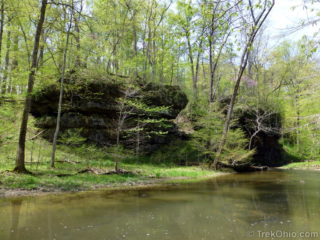 Two thousand years ago, the Hopewell people built a massive earthwork enclosing a 40-acre hilltop in southwest Ohio. This earthwork which resembles a fort was later dubbed Fort Hill.
Today Fort Hill is a 1,200 acre preserve owned by the Ohio Historical Society and operated by the Arc of Appalachia Preserve System. The preserve features 11 miles of hiking trails, a small museum, a parking area, picnic shelters, and rest rooms.
Fort Trail
We visited the preserve last September
Two thousand years ago, the Hopewell people built a massive earthwork enclosing a 40-acre hilltop in southwest Ohio. This earthwork which resembles a fort was later dubbed Fort Hill.
Today Fort Hill is a 1,200 acre preserve owned by the Ohio Historical Society and operated by the Arc of Appalachia Preserve System. The preserve features 11 miles of hiking trails, a small museum, a parking area, picnic shelters, and rest rooms.
Fort Trail
We visited the preserve last September